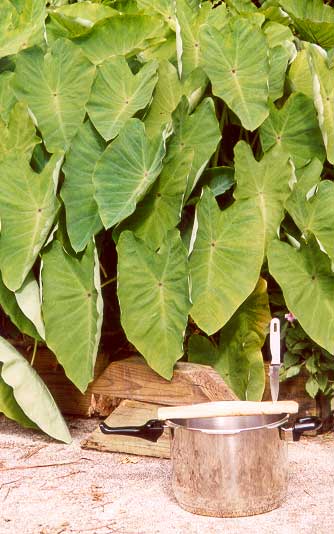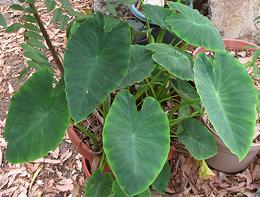how to store taro leaves
African and Caribbean cuisines feature the leaves much more prominently though they are a frequent addition to Asian dishes. Taro leaves are the large leafy green leaves that grow above ground of the taro root a common staple in many Asian cuisines.

Do Not Eat Elephant Ear Leaves Or Roots They Are From The Same Family But Not The Same A Few Tips To Try To Iden Elephant Ears Elephant Ear Plant Taro
It has an inedible paperyfibrous skin and sweet white flesh.

. Add the chopped tomatoes and diluted tamarind paste if using. Next heat up 1 tbsp of cooking oil in wok till hot. Clean and store taro tubers like sweet potatoes.
Lifted taro tubers should be stored in a cool dry place. Wipe them with a damp cloth before refrigerating. Once purchased the taro root should be left in a cool dark place and used.
Taro flesh turns. Add 1 tbsp of the previously prepared belacan into the mix. Taro is found mostly in the Pacific Islands and is imported across the world.
Taro root is the tuber of the taro plant. The leaves are best eaten when young and cooked to eliminate some of the bitterness. How to Prep Taro for Cooking.
How anyone figured out how to eat them at all is a testament to desperation hunger forces you to do things you would otherwise not do persistence keep testing out ways to eat it until you find a safe one or serendipity maybe some dude or dudette 6000 years ago accidentally threw it into a boiling pot of soup and it tasted good. Keep taro in a cool dark well-ventilated place not the refrigerator. Taro leaves pack a nutritious punch and are filled with.
However packaging reduced such losses to less than 15 that of the unpackaged crop and kept the moisture content high averaging 86. Add the garlic and chilli peppers and saute until fragrant. Gabi taro or callaloo leaves are poisonous if eaten raw.
There are more than 100 varieties of true taro but in the continental US youre most likely to only come across two of them. Taro is sometimes referred to as taro root too but while were getting technical the part of the plant we eat that is grown underground the leaves and leaf-stems are edible too is not the roots but rather the corms and cormels. How to Store Taro.
Taro leaves are also incredibly healthy and have a similar nutrient profile to other dark leafy greens. Step 1 Wash and peel the taro. They develop light green large leaves that are heart-shaped.
Also known as taro leaves gabi leaves are available in the market as either fresh leaves or dried leaves. I added 2 tbsps of water as well. Mason jars are both compact and spill-proof so theyre ideal for storing radishes in the fridge where theyll keep for up to 10 days.
Expect taro plants to grow at least 3 feet 1 m tall although they can get up to 6 feet 2 m in height. Keep taro in a cool dark well-ventilated place not the refrigerator. Its not an allergy.
Winter Care for the Colocasia. The large leaves grow from 3-6 feet 1-2 m in height so it will need some space. Whether you want to grow it for food or decoration taro prefers a.
Taro tubers can be boiled or fried like potatoes. It is best to store taro in a well-ventilated place in your kitchen such as a hanging produce basket. After about 45 minutes of cooking the taro leaves will change colour to a deeper green.
Taro is a root vegetable with edible leaves and is known by many names. Cut the taro into 1 12-inch chunks. You may use taro in just about any recipe that calls for potatoes.
Colocasia esculenta commonly called elephants ear taro or dashin produces huge ruffled leaves of green or purple that stand on 3-foot stems. Wait about 10 seconds and add in the taro leaves. How to store taro.
How to Store Radishes in the Fridge Using a Mason Jar. Taro Colocasia esculenta is a plant with a starchy root similar to a potato and its used in popular dishes around the world like Hawaiian poi and many dishes in Southeast Asia where it probably originatedIn addition taro is popular as a houseplant thanks to its dramatic leaves which are shaped like elephant ears. Dont panic though.
Native to tropical. Store taro in a perforated plastic bag. Each plant will grow one large tuber and several smaller ones.
Taro has white flesh an earthy taste resembling that of the potatoes or chestnut. Always serve taro hot because it undergoes an unpleasant texture change as it gets cold. As mentioned taro is tropical to subtropical but if you dont live in such a climate USDA zones 10-11 you can try growing taro in a greenhouse.
Unlike other root vegetables taro root cannot be stored for long periods of time. Taro tubers can be left in the ground after maturing as long as the ground does not freeze. Taro the tuber and the leaves should never be eaten raw as many varieties are toxic until you cook them.
How to Grow and Harvest Taro. Store taro in a perforated plastic bag. The leaves of the plant are also edible and are used to make the popular Caribbean dish called callaloo.
Applications Taro leaves must be cooked before consumption and are best suited for applications such as steaming frying sautéing and boiling. Taro skins are often brown and sometimes hairy so look carefully for mold as it might be. How to Grow Taro in Planters.
It can only be eaten after cooking as it is toxic when eaten raw. Taro contains crystals of calcium oxalate just beneath its peel. Wipe them with a damp cloth before refrigerating.
Wear gloves or oil your hands well for this task because taro skin contains an irritant that you want to keep off your skin. Use the largest corms first as. Live Bulbs Colocasia Elephant Ear Huge Leaf Esculenta Elephant Ear Taro Gabi Kalo Eddo Bulbs Ready to Grow Tropical Garden Plant 4 Bulps 50 out of 5 stars 2 1400 14.
Once the leaves wilt dish out and serve hot. For the unpackaged dasheen bush average weight losses of 27 35 44 and 73 day were calculated when the crop was stored at 3 10 17 and 28 C respectively. Examine taro prior to purchase for soft spots or mold on the skin.
Similar in appearance to squash or cucumber leaves you must clean taro leaves thoroughly to. Taro leaves will keep several days in the refrigerator. Different varieties of Taro exist consisting of different sizes and colors.
Taro leaves are an excellent source of ascorbic acid and dietary fiber and also contain thiamin riboflavin iron phosphorus zinc vitamin B6 vitamin C niacin potassium copper and manganese. Its those gabi leaves that are to blame. Taro leaves can be boiled like spinach.
It is best to use taro as soon as possible because it tends to soften quickly. Also patience is required since taro needs 7 months of warm weather to mature. If there are no mason jars in your kitchen cabinets you can use a pickle or jam jar instead.
Taro leaves will keep several days in the refrigerator. Fresh leaves are fantastic when cooked into creamy laing although the dried variety are much more available than the fresh kindThe fresh leaves however when cooked retain much of its bright green. This minimizes the chance of mold and softening if you cannot use the taro right away.

The Polynesian Kitchen Lu Pulu Taro Leaves And Corned Beef Luau Food Polynesian Food Fijian Food

Fresh Taro Leaf 10 Lbs Currently Unavailable

How I Pot Up My Giant Elephant Ear Taro Plants For Spring Taro Plant Plants Garden Solutions

22 Surprising Benefits Of Cocoyam Leaves Taro Leaves Men S Welfare Cholesterol Lowering Foods Cholesterol Remedies Cholesterol

This Is A Very Traditional Tongan Meal Taro Leaves Laid Out In Layers A Handful Of Diced Meat Sipi Lamb Or Tongan Food Samoan Food Polynesian Dishes

Pin On Colocasias Elephant Ears

Taro Leaf Substitutes Ingredients Equivalents Gourmetsleuth

How To Grow And Care For Elephant Ears Plant Or Alocasia Elephant Ear Plant Elephant Ear Plant Indoor Elephant Ears

Taro Leaf Samoan Food Island Rose Taro

Harvesting Cooking And Eating Taro

Fresh Patra Taro Leaves Bombay Bazaar Christchurch Facebook

Growing Taro Leaves With Actual Results And A Snack Recipe Youtube

Pin By Alyssa Chamberlain On Leaves Plants Leaves Plant Leaf Identification

Giant Taro Eat The Weeds And Other Things Too Edible Wild Plants Taro Plant Shade Plants

Taro Leaf In Product Packaging As Observed During The Grocery Store Download Scientific Diagram

The Ultimate Guide To Dalo Leaves Taro Leaves Nomlist

Geetha S Kitchen Homegrown Greens Taro Leaves Colocasia Esculenta


0 Response to "how to store taro leaves"
Post a Comment